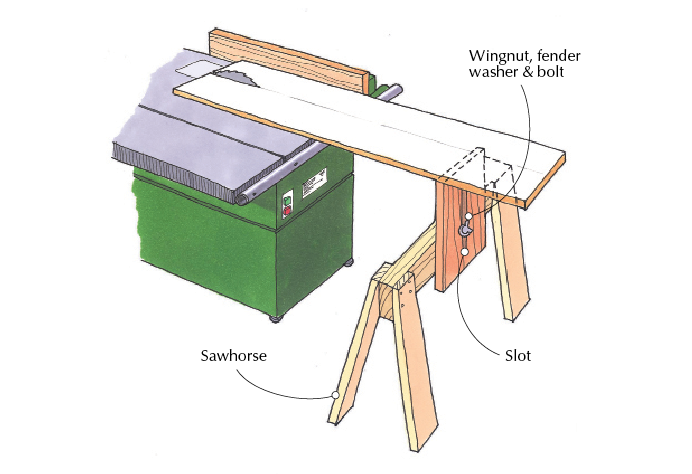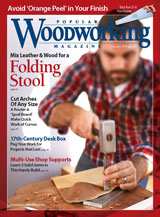We may receive a commission when you use our affiliate links. However, this does not impact our recommendations.
 I needed to cut long boards on the table saw, but had only a small table for the outfeed and none for the infeed. So I built this handy infeed table using scrap plywood and a sawhorse, both of which I already had on hand.
I needed to cut long boards on the table saw, but had only a small table for the outfeed and none for the infeed. So I built this handy infeed table using scrap plywood and a sawhorse, both of which I already had on hand.
I drilled a hole in the center of the sawhorse crossbar and cut a slot in the plywood. The ply is fastened to the horse with a carriage bolt, fender washer and wingnut. Voilà – adjustable infeed support. And it’s easy to take to plywood off to put the horse back in use for its original purpose.
Paul Donohue,
Denver, Colorado

The cover story for the February 2018 is Christopher Schwarz’s three-legged folding campaign stool – and he shows you three ways to make the legs (no lathe required for two of them!).
Ben Brunick is a master at making arches – he’s been restoring and making massive windows for a historic South Dakota building. So we asked him to adapt the process to furniture-sized work. He teaches you how to make a “spoil board” then use a router to make arches of any size, whether for a window, door or cabinet front.
In Peter Follansbee’s “17th-Century Desk Box,” you’ll learn the simple joinery that has held these handsome projects together for centuries – and they’re built with just a handful of tools.
You’ll also get inspired by whimsical furniture world of Judson Beaumont’s Straight Line Designs. Read the story behind his practice and get a look at his stunning (and fun) work.
And Willard (Bill) Anderson teaches you how to make three joints by hand as you make some handy shop supports – they’re great for cutting down lumber and sheet goods, or as a workbench in a pinch (with a piece of ply atop them).
In this issue’s “Tool Test,” we try out the new line of REVO cabinet clamps from Bessey, the Lixie Dead Blow Mallet, the new full-size handsaws from Bad Axe Tool Works (the D-8s) and the Texas Heritage Saddle Bag. George Walker encourages you to check out your local house museums for inspiration in “Design Matters,” and Peter Follansbee shares a lunette and floral carving design in a step-by-step pictorial in “Arts & Mysteries.” Bob Flexner explains what orange peel is – and how to avoid it – in “Flexner on Finishing,” and long-time woodworker Bill Murr shares his story of passing on knowledge to a young neighbor in “End Grain.” Plus Tricks of the Trade and more!
Here are some supplies and tools we find essential in our everyday work around the shop. We may receive a commission from sales referred by our links; however, we have carefully selected these products for their usefulness and quality.









Perfect, Phil! I will make use of this.